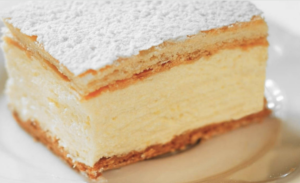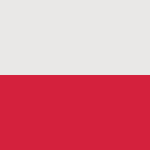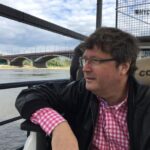Pope John Paul II
In Polish: Jan Paweł II, born: Karol Wojtyła
1920- 2005. Saint since 2014.
THE GREATEST POLE OF ALL TIME
Priest, Pope and Saint
The later Pope John Paul II grew up in Wadowice – about 50 kilometres from Krakow, where his main sin was an affinity for a type of cream cake known in Polish as Kremówki. They look like this:

Second World War
After graduating from high school in 1938, Wojtyła began studying Polish at the University of Krakow, while also being involved in a theatre troupe. During World War II, he worked with physical labour and wrote poetry. From 1942, he studied theology at a secret seminary. Doctor of Theology in 1948, after which he continued his theological research in the 1950s.
Archbishop of Krakow from 1964 and Cardinal from 1967.
The travelling pope
In 1978, Wojtyła was elected the first non-Italian pope in 455 years. At 58, he was also the youngest pope in many years. He used this youthful vigour to travel the world as an ambassador for the Holy See, where he also made use of his experience as an actor.
The Pope and communism
Whereas the Church in Poland in 1978 had found some kind of understanding with the communist system, the newly elected pope was an active opponent of communism as a system and ideology. The election of John Paul II was particularly unfavourably received by the Polish government, which was faced with social unrest and economic problems. It has been speculated that an assassination attempt on the Pope in 1981 was masterminded in Moscow. Later, however, the communist leaders seem to have accepted the Pope as part of Polish values, and from the mid-1980s Jaruzelski seemed to have an excellent relationship with him.
Pope’s marketing
As a spiritual leader, however, the Pope was received as an independent moral authority by most Poles, and the Pope was brilliant in his marketing, which included audiences with large numbers of Poles, all of whom were given a picture of themselves with the Pope. Such a picture can be found in many Polish homes, and the method was later – with the help of film director Wajda – adopted by Lech Wałęsa.
The Pope in Poland
Polish textbooks will teach students that the Pope was the reason for the fall of communism in Poland, and thus also in Central Europe and later in the Soviet Union. In particular, the Pope’s visits in 1979, 1983 and 1987 helped to give the Polish people a sense of achievement in the development of society. The Pope’s influence may be exaggerated, as there were many players who influenced the events of 1989, but there is no doubt that he played a role.

He later visited Poland twice in 1991, and I myself remember the visit to Wroclaw in 1997, where the whole city was in a state of exaltation for six months before His Holiness’ visit. But the city got a lot of new facades and squares. And then he came again in 1999 and the last visit in 2002.
Especially the first visit in 1978 probably gave strength to the future free trade union, Solidarity, when the Pope stated in front of the Tomb of the Unknown Soldier: “Let your Spirit come to the earth! Let your Spirit come down and renew the face of the land. This land!” Before the Pope said “This land”, he paused and then pointed down to the ground so that everyone understood that it was Poland.
The Pope’s viewpoints
Despite his relatively modern way of leading the church, the Pope was conservative on ecclesiastical issues. He rejected the issue of female priests, marriage for priests, and any form of mechanical and chemical contraception where condoms could have protected against the spread of the HIV/AIDS epidemic.
Death of the Pope
The Pope’s death in 2005 was a kind of collective shock in Polish society, which had become accustomed to the Pope just being there. Believers and non-believers alike seemed slightly dazed in the days when people gathered in the main squares to commemorate the Pope.
Fewer believers in Poland
Efter Pavens død er den katolske kirkes rolle i Polen svækket betydeligt. Hvor antallet af kirkegængere i 2002 var 45,7% er det i 2021 faldet til 28,3% af befolkningen. Nedgangen i kirkegængere kan dog også være på baggrund af de senere års omtale af præsters seksuelle misbrug af mindreårige samt politiseringen af kirken, hvor den Katolske Kirke til en vis grad er blevet identificeret med regeringspartiet (PiS) 2015-2023. Dog kan den almindelige vestliggørelse af det polske samfund også have spillet en rolle.
The Pope is still powerful
Despite the fact that time has brought a certain distance in papal worship, John Paul II is still seen by most Poles as a moral authority, and if you say “Pope” in Poland today, it is understood that you are talking about the Polish Pope, and not one of the modern popes that have come along since.
Please send an email to m@hardenfelt.pl if you would like an English-speaking tour guide to show you the most important places in Warsaw.


